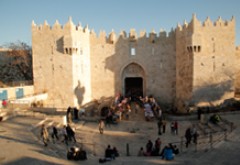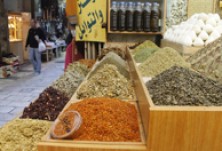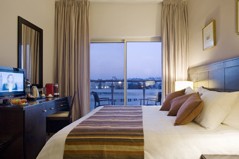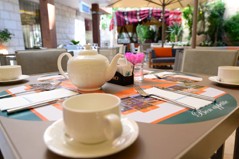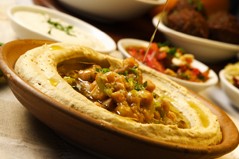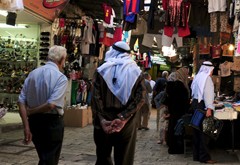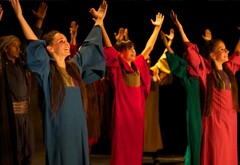Qasr al-Sitt Tunshuq can be accessed through al-Wad Street by turning west at the crossroads of the Bab al-Nazir Road that leads to al-Aqsa Mosque. It can also be accessed through Khan al- Zait Road by turning east at the crossroads of ‘Aqabat al-Takkiyya street. After making the turn, one must walk some distance to reach the façade of the palace, which cannot be missed because of its three, large, beautiful entrances.
The Site and its Names
The palace is in the middle of the southern part of the ‘Aqabat al-Takkiyya street. The location of the palace is important, because it overlooks al-Aqsa Mosque and the most prominent structures, such as the Dome of the Rock. The palace was known by several names, including Dar al-Sitt, ‘Amarat al-Sitt, al-Dar al-Kubra, and al- ‘Imara al-‘Azima. Today, it is named, along with the Khaasaki Sultan building, the House of the Islamic Orphanage.
Palace’s Components
The palace is composed of two floors, a ground floor and a first floor, with a mezzanine floor between them. The first floor comprises a large reception hall made up of a durqa’a (central hall) and two iwans (), and is surrounded from the south, east and west by a set of rooms. The palace comprises more than 25 rooms, three great entrances and several staircases. In the Ottoman era, the palace was joined to al- ‘Imara al-‘Amira (Khaasaki Sultan). When the Higher Islamic Legislative Council established the orphanage, the ground floor of the palace was dedicated to the carpentry workshop, and it still holds this workshop to this day, while the first floor was used as a sleeping area for the orphans.
West Entrance
The palace has the most beautiful and largest facade of the buildings in the Old City. It has three imposing entrances: west, middle, and east. The west entrance is adorned with colored stones known as al-Ablaq (red and grey). A written text revolves around the frame of the door, surrounding the decorative frame of the window. The text, carved with an embossed Mamluk script, contains a Quranic verse from Surat al-Hajar. It reads:
"(It will be said to them): 'Enter therein (Paradise), in peace and security.' And We shall remove from their breasts any deep feeling of bitterness (that they may have), (So they will be like) brothers facing each other on thrones. No sense of fatigue shall touch them, nor shall they (ever) be asked to leave it. Declare (O Muhammad SAW) unto My slaves, that truly, I am the Oft-Forgiving, the Most-Merciful. And that My Torment is indeed the most painful torment. And tell them about the guests (the angels) of Ibrâhim (Abraham). When they entered unto him, and said: Salâm (peace)! [Ibrâhim (Abraham)] said: "Indeed! We are afraid of you.They (the angels) said: Do not be afraid! We give you glad tidings of a boy (son) possessing much knowledge and wisdom. [Ibrâhim (Abraham)] said: "Do you give me glad tidings (of a son) when old age has overtaken me? Of what then is your news? They (the angels) said: "We give you glad tidings in truth. So be not of the despairing."
Middle Entrance
The middle entrance is the smallest and the simplest of the three, although it is the widest at 2.22 meters. It is crowned by a cinqfoil arch. The design of the door allowe easy entry,particularly since it was the door leading to the main hall (the stable). That is why the two sides of the door were chamfered. The middle entrance of the Sitt Tunshuq palace leads to a main hall that is today used for carpentry, although it appears that its original purpose was a stable.
East Entrance
The east entrance is the most elaborate and beautiful of the three entrances in the northern façade of the Sitt Tunshuq palace. The entrance was constructed in Ablaq style from red and white stone, which has turned slightly yellow. Above the door and lintel there is a stone course made up of interlocking joggled stones. This was originally done in white limestone covered with black stones that turned to grey due to climatic conditions.
Founder
Al-Sayida Tunshuq bint ‘Aebd Allah al--Muzaffariyya built this palace. Tunshuq in Turkish means ‘precious’ or ‘wonderful.’ She was a generous,compassionate and wealthy woman who loved Jerusalem, lived in it and provided it with rare architectural masterpiece. Tunshuq appears to have been a wife of one of the princes called al-Muzafar, as she acquired his title. This means that she belonged to the family of al-Muzafarin who ruled Persia, Kirman and Kurdistan (1313-1393 AD). She appears to have sought refuge in Jerusalem following a disaster that befell the ruling family at the hands of Tamerlane in 1387 AD. Tunshuq’s wealth is evident from the expansive nature of her palace and its many decorations, as well as the financial allocation that was approximately 100,000 dirhams, spent to buy one third of the village of Beit Safafa in Jerusalem.

